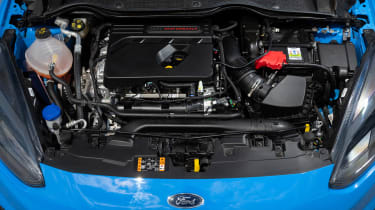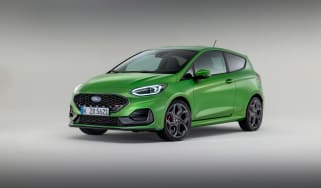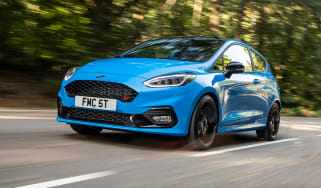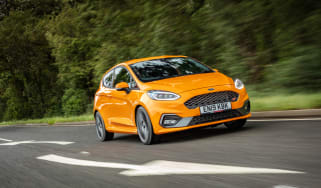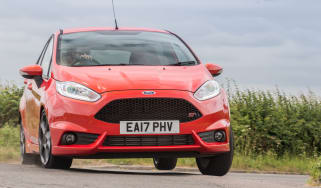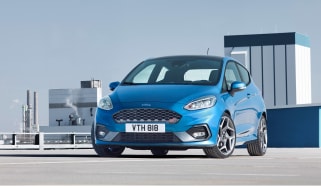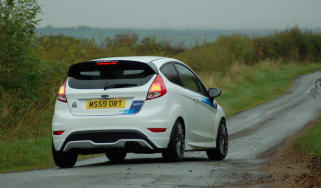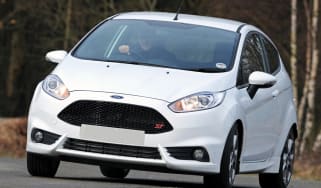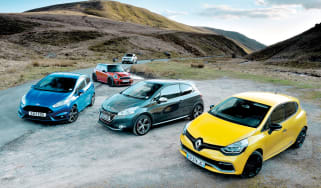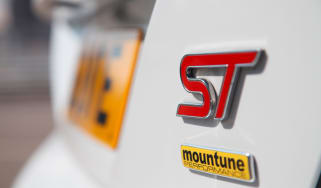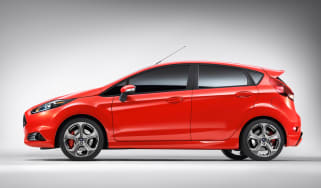Ford Fiesta ST (Mk8, 2017 - 2023) review and buying guide – a hot hatch that left on a high
Ford’s inimitably popular hot hatch arguably died before its time, but it went out on top-tier form
It’s hard to believe we now live in a world where you can’t buy a brand new Ford Fiesta, let alone the hot Fiesta ST. Especially as both remain incredibly popular models still, some almost two years on from when Ford gave them the chop.
In contrast to the all-but-barron small hot hatch market of today, the Mk8 Fiesta ST faced stiff competition on its launch in 2017. It needed to live up to its (still) brilliant predecessor, with its key rival at the time, the Peugeot 208 GTi by Peugeot Sport, at full strength and a new three-cylinder engine that had yet to be proven as a thrilling high performer.
Needless to say, it did, with fabulous chassis dynamics and a thrummy, characterful powertrain. The range featured three models, ST-1, ST-2 and ST-3, with the ‘1’ being the base model and the ‘3’ being packed with options. Ford wasted no time putting out special versions too, with the Fiesta ST Performance Edition and the Edition, which brought lightweight wheels, the usually optional Quaife limited-slip diff as standard, a lower ride height, Ford Performance coilover suspension and striking colour choices – Deep Orange for the former and Azura Blue for the latter. Just 600 Performance Editions and 500 Editions were made, with only 300 of the latter arriving on UK shores.
In 2022 the Ford Fiesta ST was then facelifted to head off new competition in the form of the Hyundai i20 N, that the Korean marque all but forged in the ST’s image. The Peugeot may have bowed out by then but the Toyota GR Yaris was very much in service, albeit as a more advanced hot hatch proposition and for a chunk more cash.
To compete in this reformed supermini class, Ford’s gentle restructure of the ST line-up in the UK saw a condensing of the range to a single, high-spec model. With few options, and a standard Performance Pack, the ST became its best out of the box – a serious little package, but one underpinned by its evergreen chassis. The only loss was potentially the ‘downgrade’ from Recaro seats, though Ford’s own items are excellent – stylish, comfy, adjustable and supportive enough.
Inside the Fiesta ST
The Fiesta’s cabin won’t be remembered as a design classic, but it does the job with solid build quality and good visibility. Material quality is good for the class, and while it doesn’t have the crystal-clear new infotainment display found on the larger Focus, it counters with physical air con controls.
It has picked up a big digital dial pack that’s found throughout the modern Ford range, but it comes with no additional customisation, and there’s a slight latency that can be irritating when changing between drive modes or making quick getaways. There was also nothing wrong with the previous analogue needles.
The updated seats are brilliant, though. Ford replaced the previous Recaro buckets with a new set of in-house seats that are just as supportive and even more adjustable. The seat base is now variable for length (previously a bugbear for, ahem, shorter drivers), and look even smarter thanks to their integrated headrests.
The steering wheel is perhaps both a little too large in diameter and a little too thick in profile – the trend for fat wheel rims shows no sign of diminishing – but overall this is a good driving position, with decently placed pedals and a snappy gearlever a relatively short movement away from the wheel.
On the infotainment side, all models include an 8-inch screen with Ford’s Sync system. A B&O Play audio system is still optional, and a worthy upgrade if you complete long journeys. Various safety systems are also included, while on the performance front you get technologies such as launch control, flat-shift gear changes, and three driver modes – Normal, Sport and Track – with varying levels of steering weight, throttle response, exhaust noise and stability control intervention.
Driving the Ford Fiesta ST
Ford’s turbocharged 1.5-litre triple had had plenty of time to bed itself into the market, proving itself to be an impressive unit that’s both powerful and flexible. In numeric terms the ST developed the same power throughout its lifeas when it was initially revealed, with peak power of 197bhp that puts it only a whisper behind the Hyundai i20 N’s 201bhp, and 214lb ft of torque.
The engine was an impressive unit, with a broad and flexible powerband that made light work of the relatively low kerb weight. The three-cylinder engine definitely has a different aural character to the old ‘four’. It’s not an unpleasant one – it’s definitely amongst the angrier threes we’ve heard – and while Ford uses sound generation to enhance its note inside the cabin (dictated by the driving modes Normal, Sport and Track driving modes) it’s not too artificial. Plus the active exhaust out back is making a ‘proper’ noise anyway, albeit it can be droney at low revs
Despite the big turbo, the ST has good throttle response from low rpm and all the way to the upper reaches of the rev counter. It doesn’t quite cover the last 1000rpm or so with the verve of the old car, though flick through the gears quickly enough and there’s sufficient torque to chirp the tyres even on the change to third.
The ST features flat shifting technology that allows you to keep your right foot pinned as you change gear. Performance is fairly typical of a hot hatch of this type, with 62mph arriving in 6.5sec on the way to a 144mph top speed. Ford’s six-speed manual transmission also spans the ST’s life, albeit with the Quaife mechanical limited-slip differential becoming standard later into its life.
It can make the steering a little fighty from low speeds, especially considering the sharp steering at its best on dry, smooth roads, but that’s all part of the thrill of a compact hot hatch like this. Thankfully, the brakes are up to the task of shedding all that speed, and while they can begin grumbling after a few hot laps around a race circuit, actual braking performance remains fairly consistent.
The steering's weighting is pretty good, though, increasing progressively through the different driving modes, though there’s not much feel until you’re really putting some loads through the tyres, at which point you’re probably travelling rather quickly. If there’s a demerit it’s that the steering is so quick you don’t really feel like you’re having to actually do much to navigate most corners, which takes away some interactivity and enjoyment on all but the twistiest of roads.
Handling was always the old ST’s strongest point and it remains so with the latest model. It’s one of the most entertaining hatches on sale – agile, engaging and always ‘up for it’, with the capacity to make short journeys to the supermarket as fun as backroad thrashes.
In terms of its layout and structure the Mk8 Fiesta ST uses much the same ingredients as other cars in this class, but throws a few herbs and spices into the mix to give the car its own flavour. Thus, you get a fairly conventional chassis set-up: steel monocoque with MacPherson strut front suspension and a torsion beam rear, with electrically assisted rack and pinion steering.
But you also get Ford’s patented ‘force vectoring springs’ – directionally wound and non-interchangeable coil springs – as an alternative to a Watt’s linkage. The aim is the same – improving lateral location of the axle – though the ability of the springs alone to apply vector forces to the suspension save the 10kg that Ford says a Watt’s linkage would add.
The ride? Well, despite a set of semi-adaptive dampers, it’s still pretty firm. The ST’s dampers vary between two rates depending on the frequency or range that the wheel is moving. When the wheel travels across a short distance but at a high frequency, as it might on a rough road, the damper reverts to its softer setting. At longer, low frequency wheel movement, that would suggest increased body roll and pitch from more enthusiastic driving, the damper uses its firmer setting.
As above, the excellent Performance Edition and Edition models came with key hardware changes, replacing the standard springs and dampers with a set of manually adjustable coilovers that, from the factory, settled the body 15mm closer to the road and calmed the ride nicely. This was combined with a set of lighter flow-formed alloy wheels that made it the most dynamic of all STs.
Economy in the real world is pretty impressive – our old long-term Fiesta ST had averaged 38.1mpg during our tenure. If you opt to take your ST on a track – a not unreasonable scenario, given how entertaining the new car is when freed from the constraints of road driving – then you’ll need to keep a beady eye on the gauge, too, as the car we tried burned through more than half a tank in a few short sessions. It is worth noting that both the i20 N and Toyota GR Yaris have quite an appetite for unleaded, with the Toyota particularly thirsty.
Prices, specs and rivals
It’s worth remembering how much the car market has changed in the years since this generation of Fiesta ST was announced in 2017 and its arrival in 2018. In its life, pricing was a real bone of contention, with the money Ford was needing to charge and the tightening margins a small part of the reason for its demise.
This was why towards the end of its life, only one high-specification five-door model was available, still called the ST-3, which to its credit included the previously optional Performance Pack, from £26,645 on the road in 2022. That’s a hair more expensive than the Performance Edition was in 2018 and a hair under £8k more than the ST’s starting price in 2018. One of the special Performance Editions can now be had from £16k while some late ST-3s remain available at closer to list price. Lower spec models without the diff and other options, can be had for less than £10k, albeit with some miles on the clock.
Hyundai’s very impressive i20 N has also been shuffled out of today’s Hyundai dealers but remains the ST’s closest adversary. The single-specification i20 was priced a bit less than the Fiesta and came with no obvious spec deficit. On the used market, they are a bit rarer and a bit pricier at £20k+. Higher up the spectrum is the Toyota GR Yaris. While there was a hefty jump in price from new, used prices start comparable to more expensive Fiestas, albeit for leggy examples. In period it was worth every extra penny thanks to the GR’s bespoke engine, chassis, body and all-wheel-drive system.
The VW Polo GTI is a long way off the Fiesta in terms of fun and capability. It has just been given an update, and while it may well have a bigger 2-litre four-cylinder turbocharged engine borrowed from its big brother Golf GTI, it’s just not that fun to drive.
You could go smaller, of course, with the Up GTI or Suzuki Swift Sport. The Up is excellent value for such a desirable car and it’s amusing to drive, too, but lacks the outright ability of the Ford. Likewise the Swift, though it does without the Up’s character, too.
Running a Mk8 Ford Fiesta ST, John Barker
In the first few miles it was the incisiveness, the startling precision and the remarkable cohesiveness of the Fiesta that impressed me. Those qualities were still front and centre in Ford’s feisty little hot hatch getting on for 9000 miles and seven months later. In that time there had been a call-up to Car of the Year, a tricky twin-test and plenty of regular miles too, and while the ST wasn’t always the perfect car for the job, it was always entertaining.
Our long-termer arrived in late September and was a top-of-the-tree ST-3 fitted with just about every option. Personally, I could have managed without a few of them, the Silver Fox paint included, which cost £750 but looked to some unkind onlookers like grey primer. The essential option was the ST Performance Pack (£850) which brought with it the Quaife limited-slip differential that enhanced the ST’s naturally sharp handling.
As standard the ST-3 is well equipped, with keyless entry, a heated front screen, heated leather seats and steering wheel, satnav, and Apple CarPlay and Android Play. Our car’s upgraded B&O hi-fi (£350) was wonderful, the auto-dimming full LED headlamps (£600) less so, and if I’d been given the choice I would have gone for the five-door version because it would have made the school run easier; the eldest of my three boys is 6ft 2in and refused to cram himself past the front seat and into the rear.
It didn’t help that the tilt and slide mechanism was rather sticky, which contributed to the release lever surround coming off in the hand of my middle boy on one occasion. Also, on the day the Fiesta returned to Ford, under the seats I found a couple of bits of mysterious plastic.
That said, we all loved the Fiesta. It’s a hatch with a confident stance, sharp on its 18-inch alloys, and it drives like it looks. It’s almost as if Ford decided that the ST didn’t have to please all of the people all of the time, that it could afford to be a strong character, a hatch with a keen sense of purpose. Its little 1.5-litre in-line three-cylinder motor pumped out a smooth 197bhp and made the ST plenty fast enough.
There was always torque on hand to test the grip of the front tyres, but only in the wet did the combination of sharp turn-in and turbocharged torque skitter the front wide, though sometimes it would grip and encourage the tail to swing round... In the dry the grip of the Michelins and torque-biasing diff helped the Fiesta corner like it had its arm around a lamppost. Again, the rear could step out but you had to be really pushing on for it to do so.
The ST’s dynamic character was partly what made it special, that and the fact it felt crafted, with even control weights and responses, like all good driver’s cars do. What it didn’t do so well was bumpy roads, which seems rather ironic for a hot hatch. This didn’t stop it doing well against much more potent and expensive competition at eCoty, but it was a characteristic more starkly revealed a few months later in the twin-test with the similarly priced Hyundai i30 N (evo 260).
Down the twiddly Elan Valley road the i30 N came into its own while the Fiesta unravelled, feeling lead-footed and clumsy. Yet everywhere else the ST felt sparky and up for it while the Hyundai was mute.
Used Mk8 Fiesta ST – buying guide
The eighth generation of Fiesta ST took over the mantle from its predecessor of being one of the most entertaining supermini hot hatches, and despite losing a cylinder and 99cc it’s still a hugely rewarding machine to drive, turning even mundane journeys into an event.
So far reliability seems to be good, though with a direct-injection engine it’s possible that carbon deposits could build up in the inlet manifold leading to a loss of performance and rough running, though this isn’t common. Also check for oil leaks around the headgasket and head cover. As the 1.5-litre Ecoboost engine is chain driven, it escapes the common wet belt issues of smaller engines in the family.
Otherwise carry out the usual used car checks – tight and consistent panel gaps and colour matches between panels, wheel kerbing, tyre make and condition and a good service history. These are small engines developing plenty of power so oil change intervals mustn’t be skipped or stretched. Remember, all Fiesta STs came on Michelin rubber – Pilot Super Sports on the earlier cars and Pilot Sport 4s on later cars – so anything less could indicate the pennies have been pinched on that particular example.
There are of course options to modify your Fiesta ST, too. Companies like Mountune and Turbotechnics offer plenty of goodies to increase power, improve handling or just add a bit of visual aggression. If your ST of choice doesn’t have the optional limited-slip diff, the aftermarket is your friend, too. Happy hot hatching.
Used Ford Fiesta ST (Mk7, 2013-2017, Mk6 2004-2008)
The Mk7 Ford Fiesta ST launched in 2013 with a 1.6-litre four-cylinder turbocharged engine that was good for 197bhp and 214lb ft of torque, and its performance was spot on, with an eager power delivery that positively egged you on to explore the chassis’s prowess. It was a hoot to drive quickly and soon became a favourite among hot hatch aficionados who could forgive it its slightly dated interior and perhaps less than class-leading build quality. The Mk7 ST arguably peaked with the sublime Ford Fiesta ST200 that served as this generation's send-off.
The first ST was introduced in 2004. It featured a 2-litre Duratec four-cylinder engine that was good for 148bhp and 140lb ft of torque, giving a claimed 0-62mph time of 7.9sec and a 129mph top speed. It faced stiff competition from the likes of the R53 Mini Cooper S and Renault Sport Clio 172 Cup, and while it was competitively priced it wasn’t quite as much of a blast to drive as its competitors.








